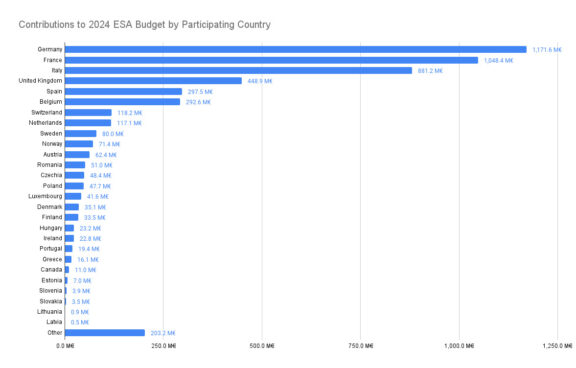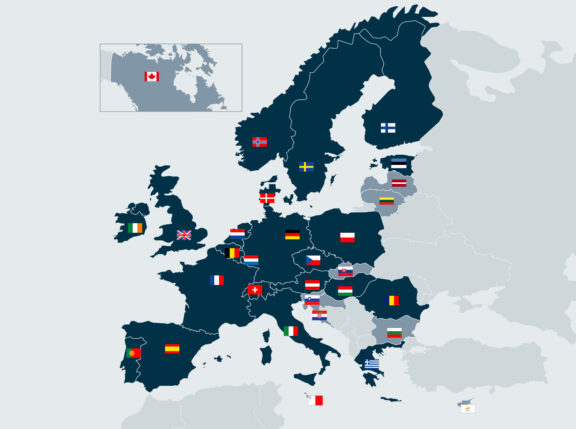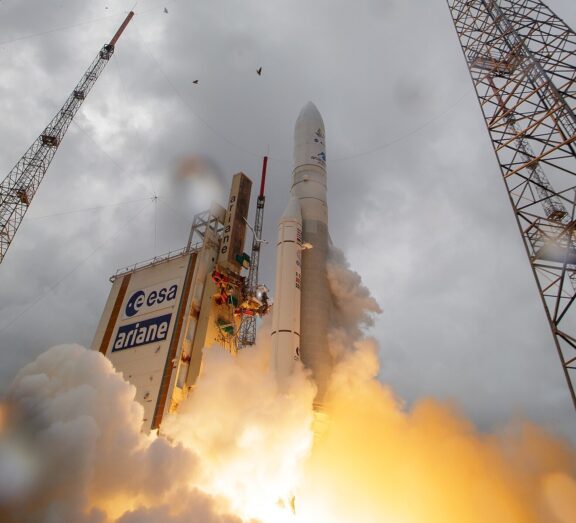How do NASA and ESA work together?
Collaboration in exploring the final frontier

Written by
Jack Kiraly
Director of Government Relations, The Planetary Society
April 4, 2024
Highlights
NASA and the European Space Agency (ESA) have a long-standing partnership that has resulted in spectacular science missions, including the James Webb Space Telescope and the Cassini-Huygens mission to Saturn.
ESA and the European Union (EU) are distinct organizations of European states with similar goals of expanding the space capabilities of the continent.
ESA has an ambitious scientific exploration program in the works, and collaborations with NASA play an important role, including in the return of scientifically significant samples from Mars.
What is the European Space Agency?
Gone are the days of national space agencies going it alone in the exploration of outer space. No agency better exemplifies this shift than the European Space Agency. If your phone or desktop background is an image from the James Webb Space Telescope, you can thank the partnership between NASA and the European Space Agency (ESA) for making it possible. But before diving into the origin and benefits of partnerships like this, it’s important to understand ESA and its role in space exploration.
ESA is not like other national space agencies in that it is not operated by a singular nation. Instead, ESA is an international organization comprised of 22 Member States, four Associate Member States, and multiple cooperative agreements with European and North American partners. The Member and Associate Member States form the Council of Ministers, each with one vote. Canada also has a vote on the Council due to the nature of its agreement with the agency. This Council determines the direction, budget, and priorities for the agency in three-year increments. This structure allows the agency to pool resources and undertake more ambitious programs while maintaining distinct national agencies with their own agenda and specialties. Each member of ESA contributes a portion of the overall agency budget. Uniquely, ESA invests in each member state at a level equivalent to the country’s contribution to the budget.

Is ESA the EU space agency?
Not quite. The European Union (EU) and ESA are distinct organizations. The EU is a supranational organization, meaning that it exists beyond the national governments of its European member states. ESA is an intergovernmental organization, existing between the governments of its member states. However, there is much overlap between the EU and ESA as both work to increase Europe’s participation in space activities.

After the formalization of an agreement between Croatia and ESA, the agency established formal ties to all EU Member States that were not already ESA members. The EU Agency for the Space Programme (EUSPA) is the EU’s counterpart to ESA, and the two groups hold regular Space Council meetings, similar to the U.S. National Space Council, to identify key programmatic goals and develop an overall coherent strategy for the advancement of space activities in Europe.
And while neither ESA nor the EU get involved in international agreements like the Outer Space Treaty or Artemis Accords, the agency’s constituent members do. Of the 22 Member States, 10 have signed the Artemis Accords. All 22 Member States, four Associate Member States, and all but one cooperating partner have ratified the Outer Space Treaty.
Friendship in exploration
There are many benefits to engaging international partners in the exploration of space, such as pooling resources, leveraging expertise across national borders, and diffusing risk, which all enhance the overall capacity for scientific discovery and technological innovation. This collaboration allows for more ambitious missions, which would be significantly more challenging for a single country to undertake both financially and technically. Partnerships like that between ESA and NASA not only accelerate the pace of scientific advancement but also foster goodwill and mutual understanding among participating nations, laying the groundwork for peaceful cooperation in space exploration.
The opportunities that open up for collaboration do not occur on a regular schedule. Instead, each agency has its own processes for the selection, formulation, and implementation of missions. Normally, the decision of if and how to engage with international partners happens early in the lifecycle of a mission. Mission architects will consider multiple options at each decision point in developing their plan, weighing the scientific, technical, and logistical merits of potential collaborations against the backdrop of political, financial, and strategic considerations. This early integration ensures that the contributions from all parties are incorporated into the mission architecture. Such collaborations, though complex, are facilitated by a shared commitment to exploration and discovery, underpinned by detailed agreements that outline the roles, responsibilities, and expectations of each partner. This has the added benefit of developing political strength for missions to weather budget and schedule uncertainty, as well as geopolitical strains.
Past partnerships
ESA and NASA have a long-standing partnership on a variety of space missions, dating back to the earliest days of both agencies. ESA has been involved in many of NASA’s largest, most ambitious, and scientifically significant missions. This is in large part due to the past successes of the ESA-NASA partnership to deliver revolutionary science.
Cassini-Huygens: This mission was a collaboration between NASA and ESA, with additional support from the Italian Space Agency. The mission comprised two main elements: the Cassini orbiter, developed and managed by NASA, and the Huygens probe, provided by ESA. The collaboration was structured around a division of responsibilities that leveraged the strengths of each partner. ESA's contribution, the Huygens probe, was designed to detach from the Cassini orbiter and descend onto the surface of Titan, Saturn's largest moon. The Italian Space Agency supplied the high-gain antenna for the Cassini orbiter and other critical hardware components. This ambitious endeavor marked the first and, to date, only landing in the outer Solar System. ESA's involvement was instrumental in maintaining the mission's scientific objectives despite budgetary constraints and the restructuring of the project by NASA. The Huygens probe paved the way for future missions to Titan, namely the Dragonfly mission being developed by the Johns Hopkins University Applied Physics Lab.
James Webb Space Telescope: The partnership between ESA and NASA on the flagship observatory was inspired by the resounding success of the Hubble Space Telescope, prompting the agencies to come together in 1996 with the ambitious goal of developing Hubble's scientific successor. ESA's commitment was solidified in 2003, with its contributions becoming a cornerstone of the project by 2007. The Near-Infrared Spectrograph (NIRSpec), designed to ESA's specifications and built by Airbus Defence and Space in Germany, incorporates detector and micro-shutter subsystems provided by NASA's Goddard Space Flight Center (GSFC). Another instrument, the Mid-Infrared Instrument (MIRI), embodies the transatlantic partnership, developed jointly by European institutions and the Jet Propulsion Laboratory (JPL) in the U.S. ESA launched JWST atop the Ariane 5 rocket on Dec. 25, 2021, placing the spacecraft at Sun-Earth L2. The European Ariane 5 performed so well that the spacecraft has enough fuel left to support an extended lifespan beyond 10 years. The minimum benchmark is five years. This collaboration has ensured ESA's full partnership in the JWST mission, granting European astronomers equal access to the telescope's observations and guaranteeing them at least 15% of the observatory's total observing time.

Future opportunities
Despite recent budget cuts to NASA, the global investment in space has never been higher. That is in large part because of agencies like ESA. At the agency’s last ministerial-level meeting in 2022, the governing council approved a 17% increase in the budget for ESA. This increase has enabled the agency to support upcoming efforts in collaboration with NASA.
EnVision: The largest proportion of ESA’s current budget is its Earth Observation program, indicating an established interest in climate science for the agency. It’s no wonder then that one of the agency’s first decisions of 2024 was to formally approve its next M-class (medium-sized) mission to be EnVision, a Venus orbiter. Venus is a compelling case study in the evolution of terrestrial planets from habitable to hellscape. NASA’s Jet Propulsion Lab is providing the Venus Synthetic Aperture Radar (VenSAR) instrument to help the spacecraft peer beneath the clouds to study the atmosphere, surface, subsurface, and interior of the planet. The mission aims to unravel why Venus, despite its similarities to Earth in size, composition, and solar distance, embarked on a radically different evolutionary path. The mission benefits from the legacy of missions such as ESA's Venus Express and NASA’s Magellan spacecraft while incorporating insights from NASA's forthcoming Venus missions, Goddard Space Flight Center’s DAVINCI and JPL’s VERITAS.
Mars Sample Return: In order to bring the samples collected by the Perseverance rover back to Earth, NASA and ESA are collaborating on a multi-phased program that involves multiple interconnected components. While NASA has collected the samples and will launch them into orbit, ESA has committed over a billion euros to the development of the Earth Return Orbiter (ERO). The ERO will autonomously rendezvous with the samples in orbit and bring them back to Earth. While MSR undergoes a reformulation following an Independent Review Board report in 2023 that identified managerial and technical concerns for the ambitious flagship program, ESA has remained steadfast in its commitment to supporting the first-ever return of samples from another planetary body.
Artemis: The ESA-NASA collaboration on the Artemis program exemplifies a groundbreaking partnership aimed at propelling human exploration beyond the familiar bounds of low-Earth orbit to the Moon and, eventually, Mars. With ESA providing the European Service Module (ESM) — the very "powerhouse" of the Orion spacecraft — this collaboration is essential to the success of future Artemis missions. The ESM is critical, providing astronauts with electricity, water, oxygen, and nitrogen and ensuring proper temperature and course maintenance for the spacecraft. The Artemis program has now survived multiple challenges that ended prior lunar return efforts, including a presidential transition and an agency-wide budget cut. This is a testament to the shared commitment of ESA and NASA to overcoming the complexities of deep space exploration, setting the stage for a new era of human and robotic exploration of our Solar System.
Support our core enterprises
Your gift today will go far to help us close out the year strong and keep up our momentum in 2026.
Donate

 Explore Worlds
Explore Worlds Find Life
Find Life Defend Earth
Defend Earth

